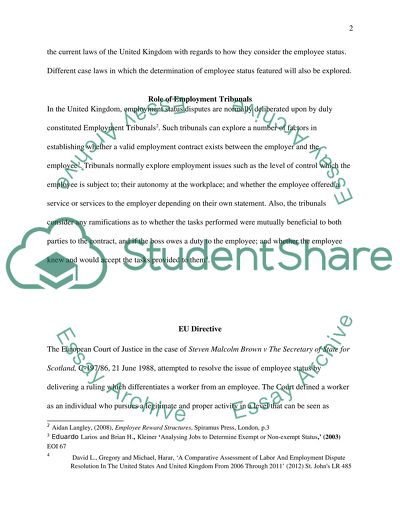Cite this document
(“In United Kingdom law the issue of employee status is largely one for Essay”, n.d.)
In United Kingdom law the issue of employee status is largely one for Essay. Retrieved from https://studentshare.org/law/1627698-in-united-kingdom-law-the-issue-of-employee-status-is-largely-one-for-the-courts-to-decide-upon-outline-the-methods-whereby-the-judges-reach-their-decisions-on-this-issue-and-comment-critically-on-the-effectiveness-of-those-methods
In United Kingdom law the issue of employee status is largely one for Essay. Retrieved from https://studentshare.org/law/1627698-in-united-kingdom-law-the-issue-of-employee-status-is-largely-one-for-the-courts-to-decide-upon-outline-the-methods-whereby-the-judges-reach-their-decisions-on-this-issue-and-comment-critically-on-the-effectiveness-of-those-methods
(In United Kingdom Law the Issue of Employee Status Is Largely One for Essay)
In United Kingdom Law the Issue of Employee Status Is Largely One for Essay. https://studentshare.org/law/1627698-in-united-kingdom-law-the-issue-of-employee-status-is-largely-one-for-the-courts-to-decide-upon-outline-the-methods-whereby-the-judges-reach-their-decisions-on-this-issue-and-comment-critically-on-the-effectiveness-of-those-methods.
In United Kingdom Law the Issue of Employee Status Is Largely One for Essay. https://studentshare.org/law/1627698-in-united-kingdom-law-the-issue-of-employee-status-is-largely-one-for-the-courts-to-decide-upon-outline-the-methods-whereby-the-judges-reach-their-decisions-on-this-issue-and-comment-critically-on-the-effectiveness-of-those-methods.
“In United Kingdom Law the Issue of Employee Status Is Largely One for Essay”, n.d. https://studentshare.org/law/1627698-in-united-kingdom-law-the-issue-of-employee-status-is-largely-one-for-the-courts-to-decide-upon-outline-the-methods-whereby-the-judges-reach-their-decisions-on-this-issue-and-comment-critically-on-the-effectiveness-of-those-methods.


